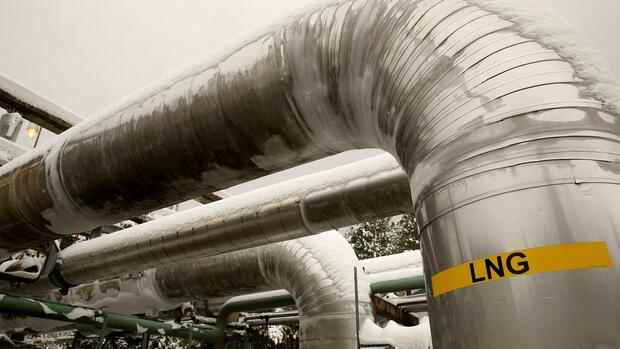Dusseldorf Europe wants to become more independent from Russia when it comes to energy supply. Above all, more liquefied natural gas (LNG) from the USA, Qatar, Australia and other countries should make this possible. However, the British oil and gas company Shell is now warning: LNG could also become scarce from 2025. In its annual market report presented on Monday, Shell analyzes the global development of supply and demand. The energy company is itself one of the largest LNG traders in the world.
Wael Sawan, director of Shell’s Integrated Gas, Renewables and Energy Solutions business, expects demand for natural gas and LNG to increase sharply in the coming years. The drivers are the efforts of many countries to phase out fossil fuels such as oil and coal. “Starting in 2025, there will be a gap between supply and demand,” says Sawan. LNG trading had already increased by six percent last year.
The demand could almost double by 2040 from almost 400 million tons today to over 700 million tons per year. So far, only production capacities of just over 400 million tons of LNG are in operation or planned worldwide.
After cold winters and because of empty storage facilities, the demand for gas is already high worldwide – and the competition for the tankers with which gas is traded in liquefied form around the world is fierce. Europe, which wants to establish LNG as an alternative to Russian pipeline gas, is primarily competing with the sharp rise in demand from Asia.
Top jobs of the day
Find the best jobs now and
be notified by email.
In order to ship natural gas with tankers worldwide, it is liquefied in the producing countries at temperatures of minus 160 degrees Celsius. In the importing countries, the LNG is then processed back into natural gas. The demand for LNG is likely to remain high in the long term, as gas is the preferred bridging technology not only in Europe but also worldwide in the energy transition and the move away from coal.
>> Read here: Gas price crisis: The LNG boom in Asia is just beginning
It is true that LNG causes high emissions of the greenhouse gas methane, which is many times more harmful to the climate than carbon dioxide (CO2). But all in all, the emissions from natural gas are only half as high as from coal. In addition, liquefied natural gas is also considered the fuel of the future in shipping and an alternative to heavy oil and diesel.
Natural gas is also becoming increasingly important for Germany
In its current energy forecast, the British oil company BP assumes that gas will be the fastest growing energy source after renewables in the next 20 years – and LNG will play a major role in this. For Germany in particular, liquefied natural gas could become important in view of the planned phase-out of nuclear power and coal.
Federal Economics Minister Robert Habeck announced in an interview with the Handelsblatt on Monday that he wanted to reduce gas dependency on Russia by diversifying on the supplier side. “LNG terminals are an additional bypass. They help to increase security of supply, ”said the Green politician. In addition, parts of the infrastructure can also be used for hydrogen imports. “The situation this winter was tight, so you have to draw a political conclusion from that,” said Habeck.
>> Read here: Climate protectors see Habeck’s commitment to LNG terminals critically – and call for alternatives
However, the planned construction and operation of its own terminal for liquefied natural gas (LNG) in Brunsbüttel, Schleswig-Holstein, is still a long way off. Around four years after the project was presented, there is still no date for a final investment decision. It is a very complex, cost-intensive and long-term investment, according to the project sponsor German LNG Terminal.
Most of the German LNG imports currently go via the Netherlands. Next to Spain, Rotterdam has the largest capacities in the EU. Although the LNG share in imports is likely to increase further in February, it does not even cover a quarter of European gas consumption.
Recently, rising prices in Europe had led to LNG tankers from the USA increasingly heading for EU ports. The USA just overtook Qatar in December and is the world’s largest LNG exporter for the first time. According to Bloomberg, 1,043 LNG ships left the United States last year. Half of it went to Asia, a third to Europe.
LNG prices remain high
Should LNG really become scarce, Asia and Europe are likely to compete even more fiercely for liquefied natural gas. According to Shell analysts, Asia, led by China, will drive more than two-thirds of global LNG demand in the coming years. Last year, China increased its imports from 12 million tons to 79 million tons, replacing Japan as the world’s largest importer of liquefied natural gas.
“However, China has already secured a large part of its demand with long-term supply contracts,” says Shell manager Sawan. In Europe, on the other hand, there is still uncertainty about financing for fossil projects with a view to decarbonization and the exact role of gas in the transition. That makes investments and long-term supply contracts difficult at the moment.
Independence from Russia is likely to be expensive. The experts at Shell warn that the LNG price is likely to remain high in view of the increasing demand. As early as 2021, it reached record highs, especially in Europe. Without long-term supply contracts, the EU is at the mercy of the volatile gas market with a significantly greater risk, according to the report.
More: Europe’s battle for gas: Russia has the upper hand – for now
